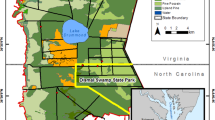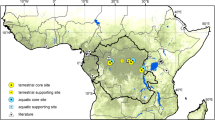Abstract
Spatial or temporal forest–peatland transition zones were proposed as potential hot spots of methane (CH4) emissions. Consequently, paludified soils are an important component of boreal landscape biogeochemistry. However, their role in the regional carbon cycle remains unclear. This study presents CH4 fluxes from two forest–peatland transition zones, two wet forest sites and two clear-cut sites which were compared to fluxes of open peatlands and dry forest. The median fluxes measured using the closed-chamber technique varied from − 0.04 to 12.6 mg m−2 h−1 during three climatically different years. The annual mean CH4 emissions of the forest–peatland transition zone were significantly lower than the fluxes of the open peatland sites, 7.9 ± 0.5 and 21.9 ± 1.6 g m−2a−1, respectively. The dry forest site was characterized by a small uptake of CH4 (− 2.3 ± 0.2 g m−2a−1). Although clear-cut forest area drastically increased in European Russia during the last two decades, if water level depths in these forests remains below 10 cm they do not act as CH4 sources. Fluxes of CH4 from the transition zone sites showed a higher response to soil temperature than to water table level. Fluxes of CH4 between the atmosphere and the two investigated peatlands were not significantly different, although a significant difference in water table level could be observed. The meteorological conditions of the investigated summers changed from being hot and dry in 2013 to cold and wet in 2014; the summer of 2015 was characterized as warmer and drier in the first half and colder and wetter in the second half. Significant differences in CH4 fluxes were measured only between 2014 and 2013. Significant differences in CH4 fluxes and in nonlinear regressions showed that the CH4 fluxes of the different site types such as dry forests, transition zones and open peatlands need to be modelled separately on a landscape level. Obviously, underlying processes vary with the ecosystem and (along with regional aspects) have to be understood first before large-scale modelling is possible.






Similar content being viewed by others
References
Asada T, Warner BG, Banner A. 2004. Sphagnum invasion after clear-cutting and excavator mounding in a hypermaritime forest of British Columbia. Canadian Journal of Forest Research 34:1730–46.
Aust WM, Schoenholtz SH, Zaebst TW, Szabo BA. 1997. Recovery status of a tupelo-cypress wetland 7 years after disturbance: silvicultural implications. Forest Ecology and Management 90:161–9.
Bonan GB, Shugart HH. 1989. Environmental factors and ecological processes in boreal forests. Annual Review of Ecology and Systematic 20:1–28.
Couwenberg J, Fritz C. 2012. Towards developing IPCC methane ‘emission factors’ for peatlands (organic soils). Mires and Peat 10: Art. 3. http://www.mires-and-peat.net/pages/volumes/map10/map1003.php
Cresto-Aleina F, Runkle BRK, Kleinen T, Kutzbach L, Schneider J, Brovkin V. 2015. Modelling micro-topographic controls on boreal peatland hydrology and methane fluxes. Biogeosciences 12:5689–704.
Dorodnikov M, Knorr K-H, Kuzyakov Y, Wilmking M. 2011. Plant-mediated CH4 transport and contribution of photosynthates to methanogenesis at a boreal mire: a 14C pulse-labeling study. Biogeosciences 8:2365–75.
Dubé S, Plamondon AP, Rothwell RL. 1995. Watering up after clear-cutting on forested wetlands of the St. Lawrence lowland. Water Resources Research 31(7):1741–50.
Fenton N, Lecomte N, Légaré S, Bergeron Y. 2005. Paludification in black spruce (Picea mariana) forests of eastern Canada: potential factors and management implications. Forest Ecology and Management 213:151–9.
Howie SA, Tromp-van Meerveld I. 2011. The essential role of the lagg in raised bog function and restoration: a Review. Wetlands 31:613–22.
Jackowicz-Korczyński M, Christensen TR, Bäckstrand K, Crill P, Friborg T, Mastepanov M, Ström L. 2010. Annual cycle of methane emission from a subarctic peatland. Journal of Geophysical Research . doi:10.1029/2008JG000913.
Joosten H, Clarke D. 2002. Wise use of mires and peatlands – background and principles including a framework for decision-making. International Mire Conservation Group and International Peat Society. Jyväskylä, Finland, 303p.
Karjalainen T, Leinonen T, Gerasimov Y, Husso M, Karvinen S. (Eds.) 2009. Intensification of forest management and improvement of wood harvesting in Northwest Russia – Final report of the research project. Finnish Forest Research Institute. Vantaa, Finland.
Karvinen S, Välkky E, Torniainen T, Gerasimov Y. 2006. Northwest Russian Forestry in a Nutshell. Metlan työraportteja/Working Papers of the Finnish Forest Research Institute 30. 98p. http://www.metla.fi/julkaisut/workingpapers/2006/mwp030.htm.
Kutzbach L, Schneider J, Sachs T, Giebels M, Nykänen H, Shurpali N, Martikainen P, Alm J, Wilmking M. 2007. CO2 flux determination by closed-chamber methods can be seriously biased by inappropriate application of linear regression. Biogeosciences 4:1005–25.
Lavoie M, Paré D, Fenton N, Groot A, Taylor K. 2005. Paludification and management of forested peatlands in Canada: a literature review. Environmental Reviews 13(2):21–50.
Lewis T. 1998. The effect of deforestation on ground surface temperatures. Global and Planetary Change 18:1–13.
Li T, Raivonen M, Alekseychik P, Aurela M, Lohila A, Zheng X, Zhang Q, Wang G, Mammarella I, Rinne J, Yu L, Xie B, Vesala T, Zhang W. 2016. Importance of vegetation classes in modelling CH4 emissions from boreal and arctic wetlands in Finland. Science of the Total Environment 572:1111–22.
MacDonald JA, Fowler D, Hargreaves KJ, Skiba U, Leith ID, Murray MB. 1998. Methane emission rates from a northern wetland: response to temperature, water table and transport. Atmospheric Environment 32(19):3219–27.
McClain ME, Boyer EW, Dent CL, Gergel SE, Grimm NB, Groffman PM, Hart SC, Harvey JW, Johnston CA, Mayorga E, McDowell WH, Pinay G. 2003. Biogeochemical hot spots and hot moments at the interface of terrestrial and aquatic ecosystems. Ecosystems 6:301–12.
McDowell NG, Marshall JD, Hooker TD, Musselman R. 2000. Estimating CO2 flux from snowpacks at three sites in the Rocky Mountains. Tree Physiology 20:745–53.
Moore TR, De Young A, Bubier JL, Humphreys ER, Lafleur PM, Roulet NT. 2011. A multi-year record of methane flux at the Mer Bleu bog, southern Canada. Ecosystems 14:646–57.
Moosavi SC, Crill PM. 1997. Controls on CH4 and CO2 emissions along two moisture gradients in the Canadian boreal zone. Journal of Geophysical Research 102:29261–77.
Nakano T, Tnoue G, Fukuda M. 2004. Methane consumption and soil respiration by a birch forest soil in West Siberia. Tellus B 56:223–9.
Nykänen H, Alm J, Silvola J, Tolonen K, Martikainen PJ. 1998. Methane fluxes on boreal peatlands of different fertility and the effect of long-term experimental lowering of the water table on flux rates. Global Biogeochemical Cycles 12(1):53–69.
Pypker TG, Fredeen L. 2002. Ecosystem CO2 flux over two growing seasons for a sub-Boreal clearcut 5 and 6 years after harvest. Agricultural and Forest Meteorology 114:15–30.
R Core Team 2016. R: a language and environment for statistical computing. R Foundation for Statistical Computing, Vienna, Austria. URL https://www.R-project.org/.
Rannik Ü, Altimir N, Raittila J, Suni T, Gaman A, Hussein T, Hölttä T, Lassila H, Latokartano M, Lauri A, Natsheh A, Petäjä T, Sorjamaa R, Ylä-Mella H, Keronen P, Berninger F, Vesala T, Hari P, Kulmala M. 2002. Fluxes of carbon dioxide and water vapour over Scot pine forest and clearing. Agricultural and Forest Meteorology 111:187–202.
RIHMI-WDC 2016. Hydrometeorological data, Baseline Climatological Data Sets, Syktyvkar Site # 23804 http://meteo.ru/english/data/.
Riutta T, Laine J, Aurela M, Rinne J, Vesala T, Laurila T, Haapanala S, Pihlatie M, Tuittila E-S. 2007. Spatial variation in plant community functions regulates carbon gas dynamics in a boreal fen ecosystem. Tellus 59B:838–52.
Runkle BRK, Wille C, Gažovič M, Wilmking M, Kutzbach L. 2014. The surface energy balance and its drivers in a boreal peatland fen of northwestern Russia. Journal of Hydrology 511:359–73.
Schneider J, Kutzbach L, Wilmking M. 2012. Carbon dioxide exchange fluxes of a boreal peatland over a complete growing season, Komi Republic, NW Russia. Biogeochemistry 111:485–513.
Taylor SJ, Carleton TJ, Adams P. 1987. Understory vegetation change in a Picea mariana chronosequence. Vegetatio 73:63–72.
Ťupek B, Minkkinen K, Pumpanen J, Vesala T, Nikinmaa E. 2015. CH4 and N2O dynamics in the boreal forest-mire ecotone. Biogeosciences 12:281–97.
Ullah S, Frasier R, Pelletier L, Moore TR. 2009. Greenhouse gas fluxes from boreal forest soils during snow-free period in Quebec, Canada. Canadian Journal of Forest Research 39:666–80.
Whiting GJ, Chanton JP. 1996. Control of the diurnal pattern of methane emission from emergent aquatic macrophytes by gas transport mechanism. Aquatic Botany 54:237–53.
Acknowledgements
This study was financially supported by German Research Foundation (DFG, SCHN 1118/2-1). We thank Misha Kuznetsov (Komi Science Centre) for providing the data on pH from the WFL site.
Author information
Authors and Affiliations
Corresponding author
Additional information
Author contributions
JS designed study, performed research, analysed data, wrote the paper; BT contributed new methods and models and wrote the paper; ML performed research and analysed data; VG performed research and analysed data; MM performed research and analysed data; HFJ wrote the paper.
Electronic supplementary material
Below is the link to the electronic supplementary material.
Rights and permissions
About this article
Cite this article
Schneider, J., Ťupek, B., Lukasheva, M. et al. Methane Emissions from Paludified Boreal Soils in European Russia as Measured and Modelled. Ecosystems 21, 827–838 (2018). https://doi.org/10.1007/s10021-017-0188-y
Received:
Accepted:
Published:
Issue Date:
DOI: https://doi.org/10.1007/s10021-017-0188-y




